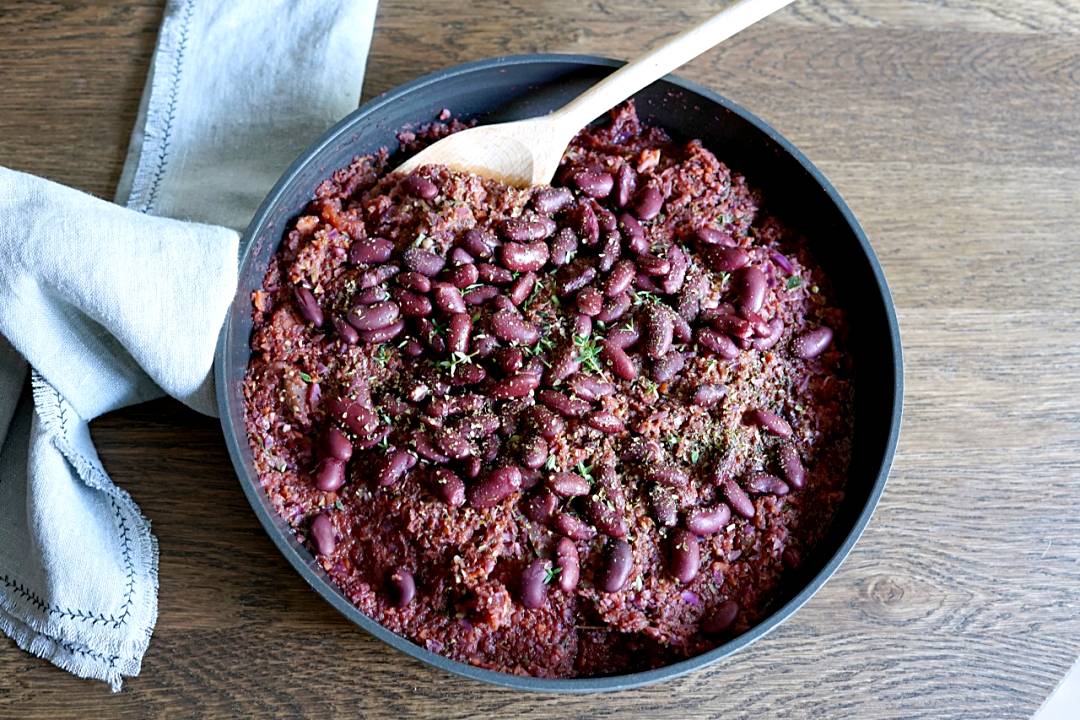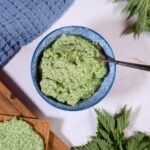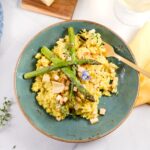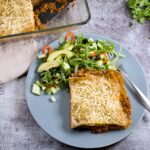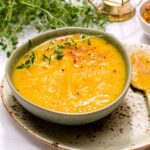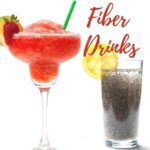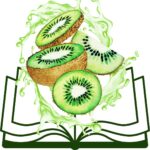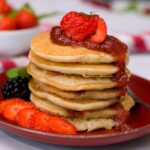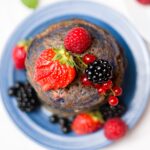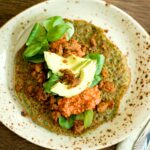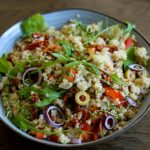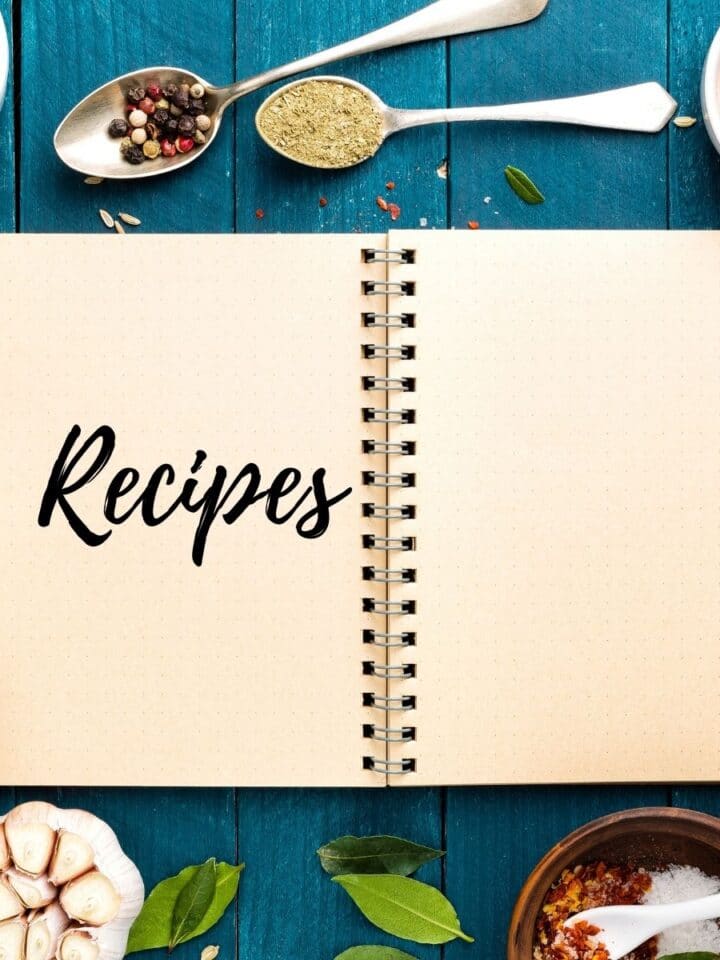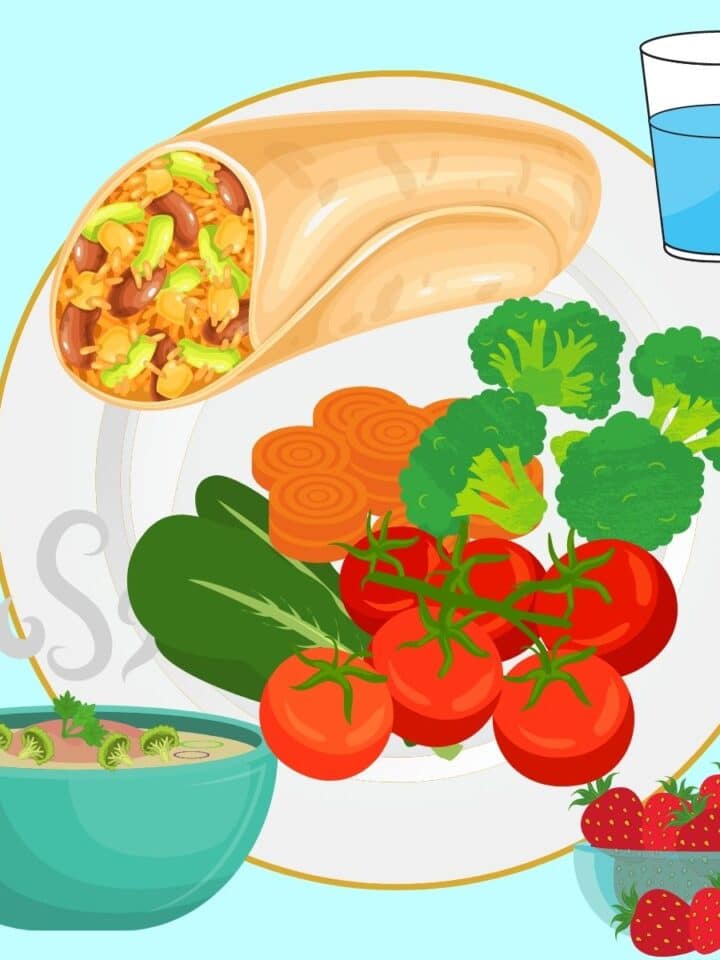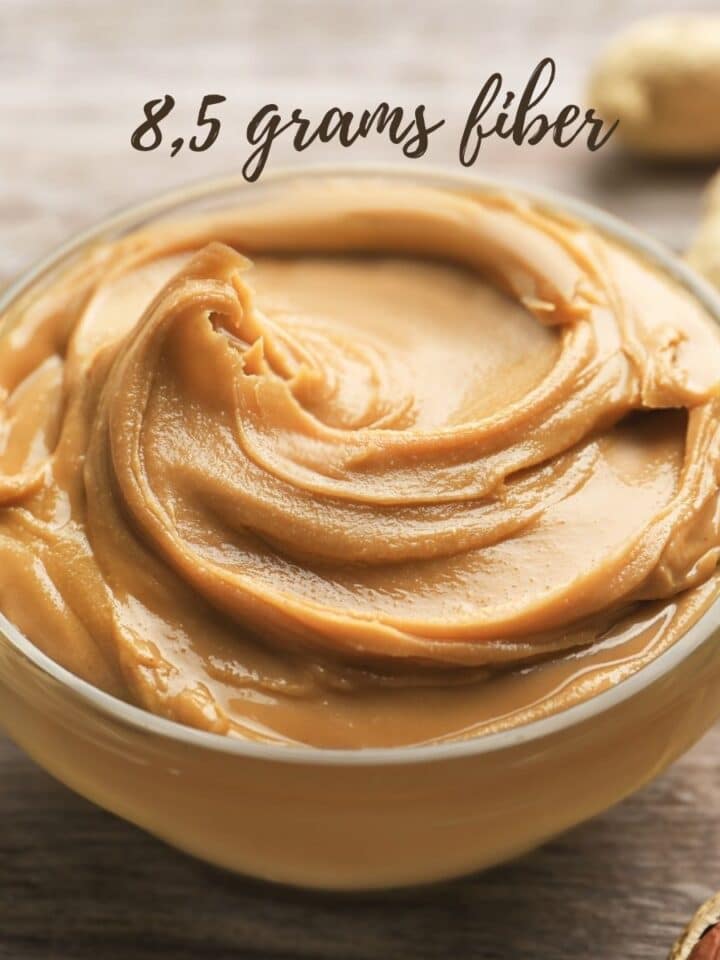What is dietary fiber? It is plant cell walls and intercellular structures. Fiber is the part of plants you don´t digest, but there are still many health benefits of eating fiber. Fiber is classed as a carbohydrate. Non-starch polysaccharides, resistant starch, and some oligosaccharides can be classified as dietary fiber.
How are dietary fibers classified?
Fiber has two main types:
- Dietary fiber. This is found naturally in grains, fruits, and vegetables. It has carbohydrates and lignins.
- Functional fiber. This is the fiber that is extracted, isolated, or synthesized with different processes from foods. Functional fibers are often added to processed foods and used as supplements. (Source)
Fiber can also be divided into
- viscous and non-viscous
- fermentable vs. non-fermentable.
- soluble and insoluble fiber. (Most common classification)(source)
Table of fiber types and food sources
| Main types | Subgroups | Isolated fibers | Food sources |
|---|---|---|---|
| Non-starch Polysaccharides | Cellulose | Brans, legumes, nuts, peas, cereal. | |
| Non-Starch Polysaccharides | Hemicelluloses | Galactans Glucans Xylans Mannans | Brans, cereal grains, legumes, nuts, vegetables, fruits. |
| Non-Starch Polysaccharides | B-Glucans | Whole grains like oat, barley, rye. | |
| Non-Starch Polysaccharides | Pectins | Fruits, vegetables, legumes, potatoes, sugar beets. | |
| Non-Starch Polysaccharides | Gums | Galactomannans: Guar Gum, Carob, Locust, Tara Acacia, Karaya, tragacanth gums. Alginates Xanthan, gellan Psyllium | Legumes, seed extracts, tree extracts, seaweed extracts, microbial gums, the outer layer of seeds. |
| Non-Starch Polysaccharides | Fructans | Inulin(oligofructose) | Chicory, onion, artichoke, agave, wheat. |
| Non-Digestible Oligosaccharides | Fructooligosaccharides Galactooligosaccharides Xylooligosaccharides Arabinoxylanooligosaccharides Soybean oligosaccharides | ||
| Resistant Starch | 4 types; inaccessible, native granules, retrograde, and chemically modified. | High amylose starch and maize, high-maize. | Legumes, seeds, Whole grains, Unripe bananas, raw potatoes, heated and cooled starchy foods |
| Fibers are found in animals also. | Chitin and chitosan | Crustaceans and some funghi | |
| Other fibers in plants | Lignin Cutin Suberin Waxes | Woody plants, stems, leaves, flower parts, fruits, tree bark, cuticle of vascular plants. | |
| Chemically synthesized fibers | Dextrin Polydextrose Cellulose derived PolyGlycompleX |
One plant has many fiber types; by eating various vegetables, grains, fruits, and berries, you naturally get different types of fiber. All fibers feed unique microbes in your gut. If you eliminate a food group, then those microbes that feed on those fibers get weaker and die.
There are millions of fibers in nature; this article presents a small introduction to some of the most common ones.
Jump to:
- How are dietary fibers classified?
- Table of fiber types and food sources
- Difference between soluble fiber and insoluble fiber
- Soluble fiber
- Insoluble fiber
- Soluble and Insoluble fiber types chart
- Cellulose
- Hemicellulose
- Chitin and chitosan
- Resistant starch
- Lignin
- Beta-glucan
- Psyllium
- Pectin
- Guar gum
- Inulin
- How much fiber do you need to eat?
- Read more about fiber in fiberfoodfactory
- High fiber recipes

Difference between soluble fiber and insoluble fiber
Soluble fiber dissolves in water. Insoluble fiber does not. Most plants contain both types of fiber. Most of the fiber, 70-80%, is insoluble, and 20-30% is soluble. Grains have much insoluble fiber, but fruits, berries, legumes, oats, and barley have soluble fiber.
How fast does food travel through the digestive tract? When you have eaten lunch, the stomach becomes empty in 2-5 hours. If you eat fruits, berries, beans, oats, barley, or fat, this makes the process slow down. The breakdown food stays in the small intestines for 3-6 hours. The mass stays in the colon for 2-3 days. Soluble fiber makes the process faster in the colon to 1-2 days.
Soluble fiber
Helps with weight management. Soluble fiber slows down digestion and makes you feel fuller for longer. If you eat fruit before dinner, this reduces the amount of food you are going to eat. The soluble fiber in fruit binds water effectively. The fiber swells and forms a gel that stretches the stomach. Stretch receptors activate and message to the brain it got food. Brains satiation center activates.
Reduces risk of diabetes. Soluble fiber slows down the stomach's emptying, which makes the carbs break down more slowly. Sugar is absorbed more slowly in the bloodstream, and this affects insulin levels. Insulin is released moderately when you eat meals with soluble fiber.
Lowers cholesterol. Soluble fiber also affects cholesterol levels since it binds cholesterol in the small intestines to an unabsorbed form. Beta-glucan is a well-known soluble fiber in oats that is widely marketed as a cholesterol-lowering agent.
Feeds healthy gut bacteria. Bacteria in the colon break down the soluble fiber. This process forms short-chain fatty acids. The PH gets lower, and this increases beneficial bacterias in the colon.
Normalizes stool consistency. It can soften hard stool in constipation and firm loose stool.
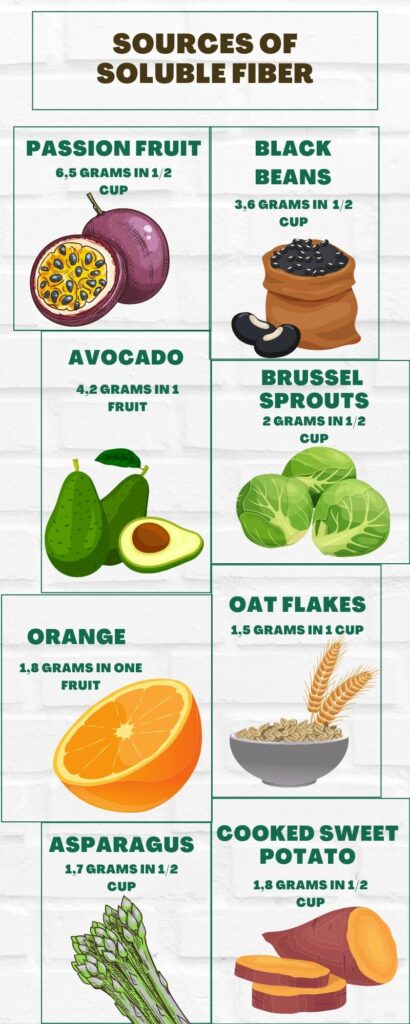
Insoluble fiber
Aids the growth of beneficial gut bacteria.
Supports insulin sensitivity.
Bulks stool mass and improves regularity. Insoluble fiber makes the bowel work faster; it bulks up the mass in the colon. Bacteria do not break down insoluble fiber. Muscles in the gut mix and push the mass forwards. This makes the colon work faster, and you don't have to suffer from constipation. Especially if you also keep your body moving and drink enough water.
Can prevent hemorrhoids. Regular bowel movements and function are important in preventing hemorrhoids, so it is important to eat enough fiber.
Decreases risk of colon cancer. The concentration of harmful substances becomes lower when you eat insoluble fiber, so they can not cause cell damage.
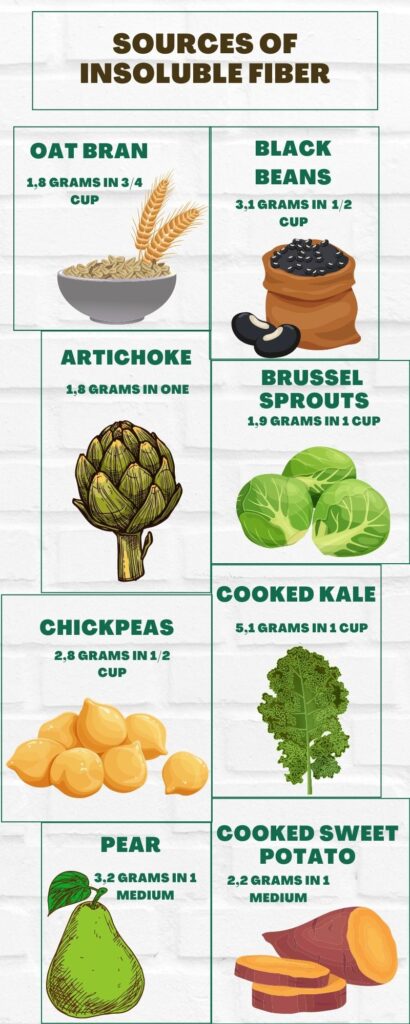
Soluble and Insoluble fiber types chart
| Types of fiber | Soluble or insoluble | Sources |
|---|---|---|
| Cellulose | Insoluble | Broccoli, cabbage, kale, cauliflower, legumes, nuts, bran. |
| Hemicelluloses | Both | Polysaccharides in plant cell walls. Found, for example, in green beans. Glucomannan, konjac (herb) is most known. |
| Chitin and Chitosan | Insoluble | In the exoskeleton of crabs and lobsters and cell walls of fungi. Functional fiber and consumed as supplements. |
| Resistant starch | Insoluble | Found in starchy foods, can also be a functional fiber by processing. |
| Resistant Dextrins | Insoluble | A functional fiber that is made of cornstarch. |
| Lignin | Insoluble | Flaxseeds, root vegetables, bran, stems, fruits, especially strawberries and peaches, brazil nuts. |
| Beta Glucan | Soluble | Barley, oats, fungi, and algae. |
| Psyllium | Soluble | Psyllium seed |
| Pectin | Soluble | Fruits and berries |
| Guar Gum | Soluble | Fiber from the seed of the guar plant. |
| Inulin | Soluble | Fruits, vegetables; bananas, garlic, onions, asparagus, wheat, rye. |
Cellulose
You might have heard of cellulose only concerning industrial production, and it is true cellulose fiber is used, for example, in the textile industry. Cellulose is the main fiber in plant cell walls. Cellulose is indigestible, but it still mixes easily with water. You naturally eat cellulose in whole foods. Cellulose prevents gut inflammation.
Cellulose is a popular fiber to add to foods. If you see products in the store that says added fiber, it often is cellulose. Powdered cellulose can be made from the pulp of wood or cotton and used in the food industry as a texturizing agent, anticaking, or as a thickening agent, especially in sauces. It is also added as a calorie reducer in foods.
Cellulose can be found in ice creams. As a thickening agent, it is used to create a thick creamy, fluffy consistency. Some grated cheeses, spice mixes, and powdered drinks also have cellulose added since it can function as an anti-caking agent.
Hemicellulose
Hemicellulose also helps to strengthen plant cell walls like cellulose does, they interact with the cellulose. There are different types of hemicelluloses; examples are xylans, mannans, galactans, rhamnans, and arabans, also combinations of these. Hemicelluloses can be soluble and insoluble. Hemicellulose is used in foods as a thickener, emulsifier, or stabilizer. Hemicelluloses are also used in some prebiotic supplements.
The most known hemicellulose is glucomannan. This is a soluble fiber also known as konjac. Konjac or elephant yam is a plant that grows in Asia. Konjac is most sold as a fiber supplement for weight loss. It also helps lower total cholesterol levels.

Chitin and chitosan
Chitin and chitosan are found in mollusk shells, fish scales, and fungi cell walls. You might eat chitin if you have shrimp, lobster, mushrooms, or insects on your plate. It is mainly used as a nutritional supplement and in the food industry as an emulsifier and stabilizer. Since chitin has antibacterial effects, it also acts as a preservation agent.
The easiest way to eat chitin is to eat cricket bread. Cricket flour or powder is sold in internet stores. Eating insects has become a boom. There are many recipes on the internet containing insect powders.
Resistant starch
Most carbohydrates are starches. Starch can be divided into different fractions based on the digestive rate; rapidly digesting starch, slowly digestive starch, and resistant starch. Resistant starch is categorized as a type of insoluble fiber since it is not digested in the small intestines.
There are also different types of resistant starch. Also, the starch type in foods can change. For example, green bananas have a lot of resistant starch, but as they ripen, the starch changes to regular.
Resistant starch is most known for aiding in weight loss. It helps with your appetite. Resistant starch also lowers blood sugar levels after meals; it can improve insulin sensitivity if you consume it every day for some weeks. Resistant starch is also good for digestive disorders like inflammatory bowel diseases.
Resistant starch increases the amount of microbiota, the good microbes in your gut. It is formed to short-chain fatty acids in the bowel by fermentation. Acetic, propionic, and butyric acids are formed.
Foods that contain resistant starch:
- Unripe bananas
- Legumes and beans
- Cooled cooked potatoes
- Cooled cooked pasta
- Cooked and cooled wholegrain rice
- Barley
- Raw oats
- Cashews
Maybe the most known way to get resistant starch is raw potato starch or Hi-maize flour. This can be mixed in cold water and drank. It is commonly used as an aid to stomach problems and diarrhea.
As a rule of thumb, you can remember that cooling starchy food after cooking increases the resistant starch, so this is why it is good to eat your pasta and potatoes cold.
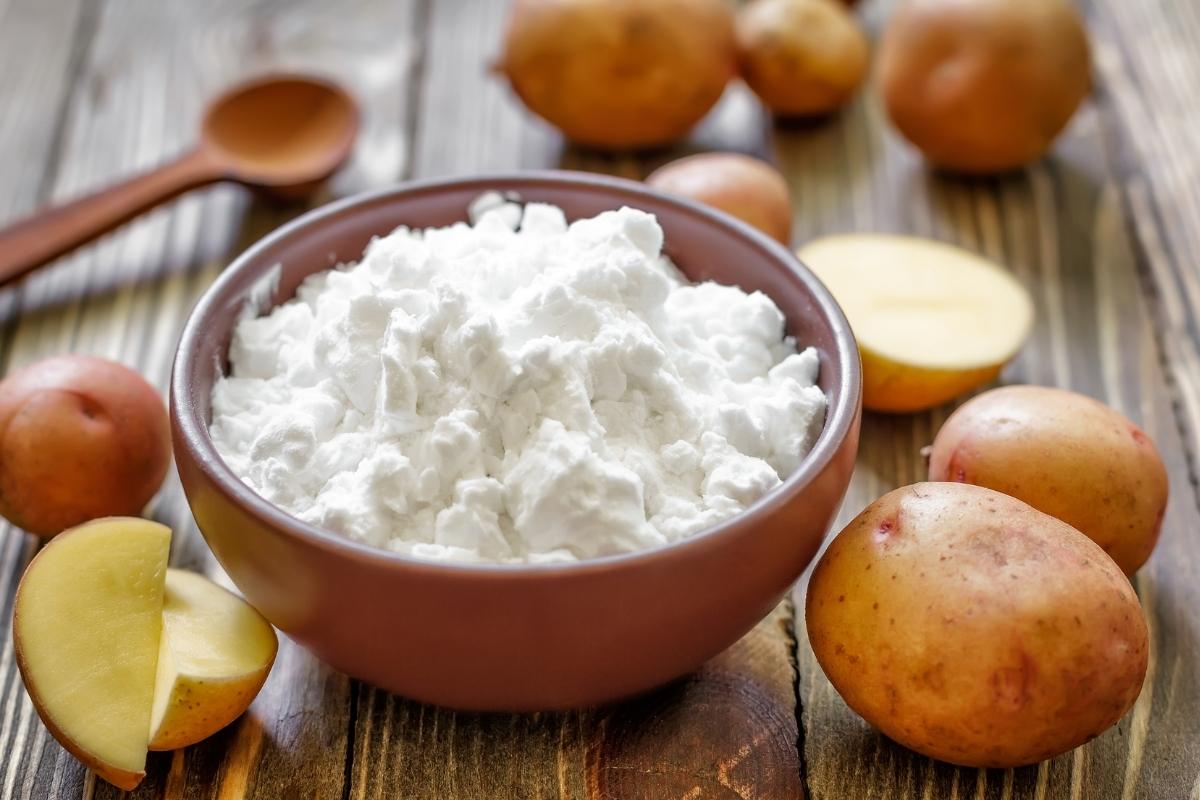
Lignin
Insoluble fiber. Lignin is a part of plant cell walls and occurs in association with cellulose and hemicellulose. Lignin makes the "woody" parts in vegetables like in carrots and broccoli and is also in fruits' seeds. Lignin is also in the outer husk of grains. You get lignin if you eat whole grains, but not from white wheat, where the outer husk is removed. Legumes, green beans, cauliflower, zucchini, avocado, flaxseeds, and unripe bananas are examples of other foods that contain lignin.
Beta-glucan
Soluble fiber that forms into a gel. You might know the name beta-glucan from many packages that promote cholesterol-lowering capacity. Beta-glucan is effective in lowering cholesterol, and the U.S. Food and Drug Administration has approved a heart-healthy label for foods that contain a high amount of beta-glucan.
Beta-glucan is in:
- Whole grains like oats, bran, wheat, barley.
- Some fungi
- Also sold as supplements
Psyllium
Psyllium is a soluble fiber. It is very viscous. Psyllium is not found in all plants. It is the husk of the psyllium plant(Plantago ovata). Psyllium is quite tasteless. Psyllium is sold as husk, powder, granules, and capsules.
Psyllium forms a gel that binds sugars and helps reabsorption of cholesterol. Psyllium has many health benefits and can be used to treat and prevent diabetes, colon cancer, and inflammatory bowel diseases. Psyllium is most known as Metamucil, a fiber supplement sold to reduce constipation. Psyllium is also used to help with diarrhea.
You can buy psyllium separately in stores, usually in the baking/flour aisle. Psyllium is often used in gluten-free and keto baking because it brings fluff to bread. Psyllium is also added to some cereal.

Pectin
Soluble fiber. Found in many fruits like apples, strawberries, citrus fruits, carrots, and potatoes. When pectin is combined with sugar and acid, it forms a gelly structure; this is why it is used when making jams. You can find pectin in bags on the baking/spices aisle in stores.
There are two main types of pectin, the other is fast-set and makes chunky marmalade, and the other is slow-set and is used for clear jellies. Pectin does not taste anything, so this is why it is good to use in marmalades.
Pectin can have health benefits like other fibers, but it has not shown to have the same powerful effects for example in blood sugar levels and cholesterol.
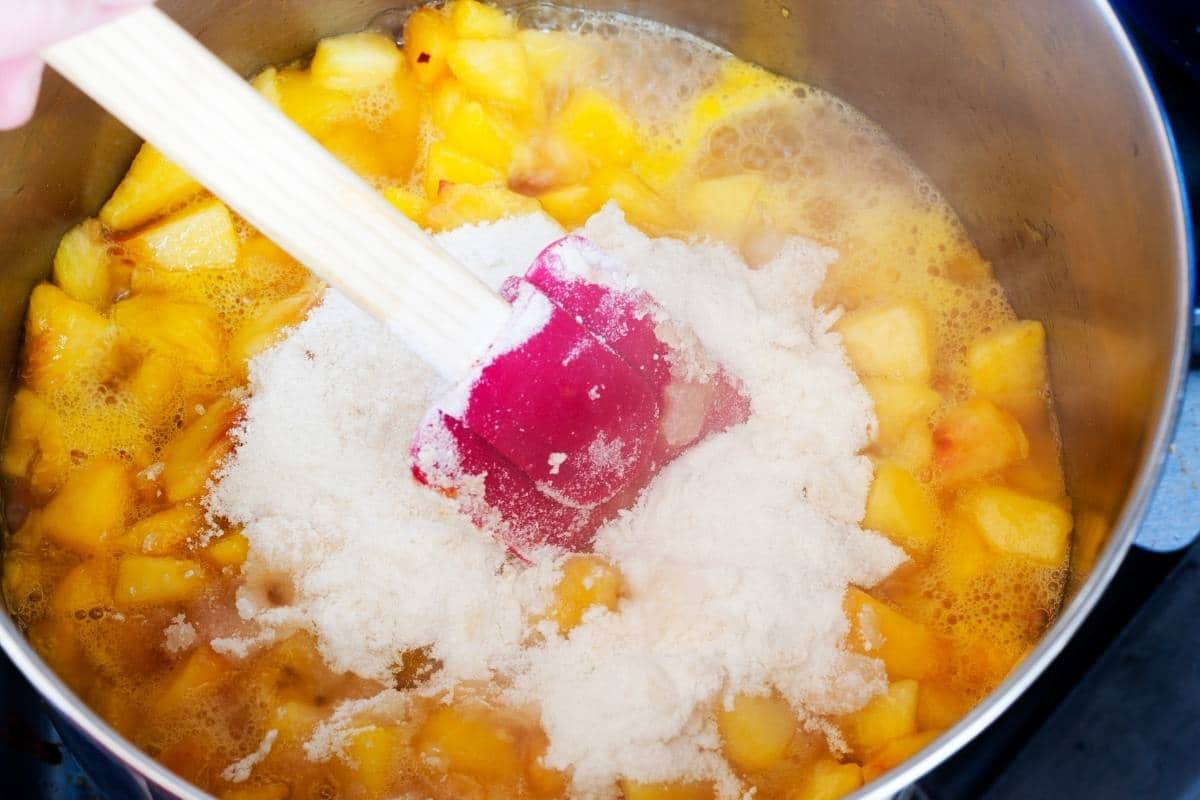
Guar gum
Guar gum is made from the guar plant by milling the endosperm of the seed. Guar gum contains galactomannan. It is highly viscous and used in the food industry since it is thickening, gelling and stabilizing.
Also, guar gum has health benefits and can be a good fiber for those suffering from IBS. It should be, though, used in moderation since too high dosages can cause gas and bloating like other fibers also do.
Inulin
Inulin is a fermentable fiber, a fructan. It ferments at the end of the small intestine, where short-chain fatty acids are formed. The SFCAs helps in the growth of probiotics like bifidobacteria. So Inulin has many health effects.
Inulin often causes problems for IBS patients, those with irritable bowel syndrome. They are sensitive to fermentable fibers, and they often cause stomach pains. Inulin is found in onions, garlic, wheat, and rye. People with Ibs rarely can eat those foods in high amounts. Often it is not the gluten in wheat that causes problems but the fructans in it, the inulin.
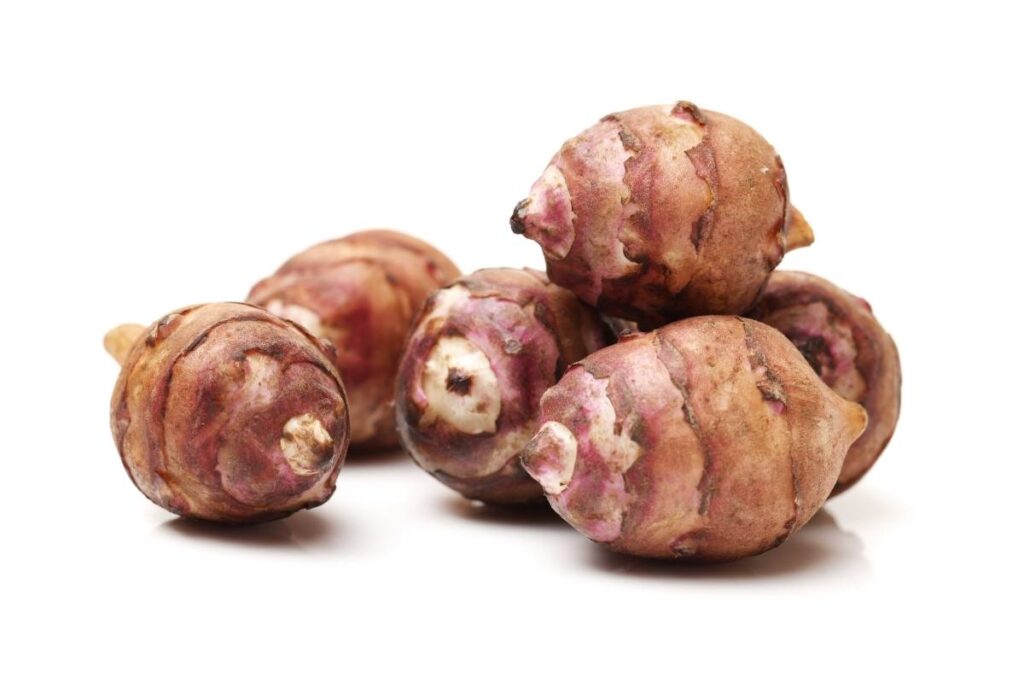
How much fiber do you need to eat?
Recommended fiber intake for women is 25 grams and 38 grams for men. These are though minimum recommended intakes, it is better to eat more. Average Americans don´t get even the minimum amounts from food. The mean fiber intake is 15-17 grams.
For children with a lower calorie intake, 14-23 grams is recommended by the USDA dietary guidelines. Fiber intake minimum is easy to count—14 grams per 1000 calories. 14 grams is enough for a child, but a male eating 3000 cal a day should get a minimum of 42 grams of fiber a day.
As you have learned from this article, fiber comes in many forms. Fiber often causes people problems when they start to eat more plant foods. Gas, cramps, and other stomach issues can feel discomforting, but this is because the gut flora is out of balance.
With time the microbiome in your gut can get healthier, and you develop more healthy bacterias. The more fiber and the more diverse fibers you eat, the better your gut will start to feel. But not only your gut but your overall health. It is the transition period that is difficult.
I always recommend getting the fiber from whole foods. If you are having trouble eating more fiber, then you can try to use specific fibers. this can especially be beneficial to IBS patients since some fibers that are fermentable can cause some problems.
Read more about fiber in fiberfoodfactory
- What foods are highest in fiber
- Types of soluble fiber and health benefits
- 45 high soluble fiber foods
High fiber recipes
